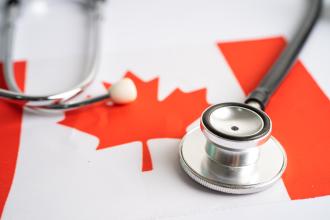Up in smoke
It’s common knowledge that most physicians abhor patient confrontation. The nature of our profession is to give care and compassion, and to advocate for our patients. In a previous editorial I wrote that those same caring qualities can be exploited when patients present with requests of questionable merit—for drugs, disability forms, or medical marijuana.[1]
The purpose of this editorial is not to question the therapeutic virtues of medical marijuana,[2] nor is it to call attention to the elephant in the room—legalization. Instead, this editorial is about you, the physician, who on 1 April 2014 will be handed the spoils of the failed Health Canada Marijuana Medical Access Regulations (MMAR) experiment.
Currently the MMAR provides rules and regulations about how patients can qualify for legal access to marijuana. Admittedly, completing and processing the required forms B(1) and B(2) can be cumbersome and slow. Once authorized, the patient is granted permission to purchase marijuana or, on further application, to grow it. Not surprisingly, the grow-op option has become increasingly popular, with such operations bringing the risks of fire, pesticides, and crime to the neighborhoods in which they operate. As one grower readily admitted, “excess production goes to pay for the expensive electricity bills.”[3] Increasing administrative costs and protests from municipalities, police forces, and fire departments have resulted in a rethink of the MMAR program by Health Canada.
Under the newly proposed regulations—entitled “Marijuana for Medical Purposes Regulations” (MMPR)[4]—a patient can now be approved for access to medical marijuana by a physician or possibly a nurse practitioner. No more applications to Health Canada because of course you, the physician, are equipped with complete knowledge of marijuana pharmacotherapy and the scientific evidence for its medical use. You will now become the conduit or barrier for access to marijuana.
Should you support patient access to medical marijuana following your assessment, you will need to complete a medical document similar to a prescription, noting patient identifiers, your licence number, where the patient was assessed, duration of authorization (maximum 1 year) and the marijuana quantity in grams. If you don’t know anything about the required quantity, product strength, or composition, in most cases your patient will happily help you out.
With your authorization, the patient will be able to obtain medical marijuana from a licensed producer. In order to be licensed, producers must be large scale, have physical security measures, maintain records, and collaborate with fire authorities, municipal government, and local police. Storefront or retail distribution centres are forbidden and dried marijuana will be obtainable only if shipped securely in 15-gram maximum, childproof containers with patient-specific labeling similar to a prescription. While patients are assured confidentiality when filling prescriptions for other medications, suppliers will be required to reveal the identity of registered clients upon police inquiry.
But wait, there’s more! Under the new regulations, a pharmacist or a physician can also become a distributor for medical marijuana. You might find it ironic that while pharmacists are increasingly venturing into some aspects of the practice of medicine, finally physicians will be allowed to dispense—albeit only for medical marijuana!
Some physicians may see a Seagram-like business opportunity[5] in the proposed regulations, but be aware that the College regulates the marketing of products sold in physician offices. Moreover, it is doubtful that Health Canada would allow for unmonitored authorization and dispensing of medical marijuana. The issue of how physicians will be audited for authorizing a substance of unknown composition, potency, and sparse evidence-based indications for use will also arise and will need to be addressed.
Over the past decade we have seen the relaxation of marijuana restrictions in North America and Europe. The proposed Marijuana for Medical Purposes Regulations may address a number of significant problems caused by grow-ops, but when Health Canada proposes to foist legal access to marijuana onto the shoulders of physicians, we naturally ask, “What are they smoking?”
—WRV
References
1. Vroom B. Medical marijuana. BCMJ 2010;52:329.
2. Fletcher J. Marijuana is not a prescription medicine. CMAJ. Accessed 26 April 2013. www.cmaj.ca/content/185/5/369.full.
3. Henderson PJ. Chilliwack marijuana grower faces new hurdles with federal legislation. Vancouver Sun. 29 March 2013. Accessed 26 April 2013. http://www.vancouversun.com/health/Chilliwack+marijuana+grower+faces+hur....
4. Government of Canada Department of Health. Controlled Drugs and Substances Act. Canada Gazette: Marihuana for Medical Purposes Regulations. 15 December 2012. Accessed 29 April 2013. http://gazette.gc.ca/rp-pr/p1/2012/2012-12-15/html/reg4-eng.html.
5. Barmak S, McCullough M. Canadian Business. How big business will make billions on the legalization of pot. 13 March 2013. Accessed 29 March 2013. www.canadianbusiness.com/companies-and-industries/marijuana-inc/.

